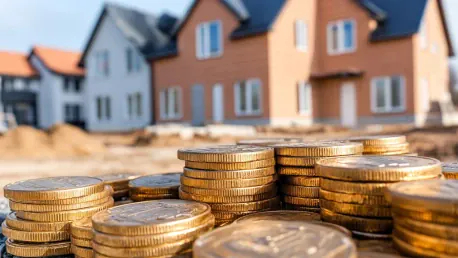In recent years, the residential construction industry has experienced significant fluctuations, posing substantial challenges for developers, buyers, and policymakers alike. The most notable variation is the divergence in building costs between different types of homes. As construction costs for new standalone houses have reached unprecedented highs, the expenses incurred for retirement village units and apartments have seen considerable declines. This drastic variation has had a multifaceted impact on the housing market, affecting everything from affordability to investment trends.
Analyzing Trends in Home Construction Costs
Record Highs for Standalone Houses and Townhouses
The average construction cost for new standalone houses peaked at $3,245 per square meter in Q4 2024, bringing the average total to an impressive $449,517, excluding land costs. While this figure has seen a slight reduction from the Q3 level of $3,285 per square meter, the decrease offers little assurance of a sustained downward trend. Historically, such minor dips have not significantly influenced the broader trajectory of soaring costs. Standalone houses and townhouses both set new records in their building costs, averaging $3,279 and $3,157 per square meter, respectively, in the same quarter.
The demand for standalone houses has kept the pressure on construction costs, exacerbated by the global supply chain disruptions and material shortages experienced over the past few years. Despite this, there remains a persistent demand for such homes, which are often viewed as long-term investments favoring space and privacy. The increase in building expenses aligns with broader economic trends, including rising wages and inflated costs for raw materials, lending support to the argument that these elevated figures might be here to stay.
Declining Costs for Apartments and Retirement Units
In stark contrast to standalone homes, the fourth quarter of 2024 saw the construction cost for apartments drop to $3,364 per square meter, marking its lowest point since Q3 2021. Similarly, the costs for retirement village units experienced a notable decline, with numbers falling to $3,342 per square meter, the lowest in a year. These decreases can be attributed to a variety of factors such as advancements in construction technologies, more efficient building methods, and possibly a response to waning demand in specific segments.
The reduced costs for building apartments and retirement village units indicate a shift in market dynamics, where economies of scale and bulk purchasing agreements have played a considerable role in driving prices down. Developers in this sector have benefited from these efficiencies, potentially allowing savings to be passed on to consumers, although market prices are also subject to external factors like location and local economic conditions.
Regional Variations in Construction Costs
Insights from Major Regions
Regional data provides a more nuanced understanding of these disparate trends across different areas, such as Auckland, Waikato, Bay of Plenty, Wellington Region, Canterbury, and Otago. For instance, Auckland, which consistently ranks among the most expensive regions for construction, saw variable changes across different types of housing. While building standalone houses here remains significantly costly, certain local initiatives have aimed to mitigate these expenses through policy reforms and incentives for developers.
Other regions like Waikato and Bay of Plenty also reflected similar variations, although generally at a lower cost threshold compared to Auckland. These areas have experienced a steady demand for new builds, influenced by internal migration and the appeal of a more suburban lifestyle. The Wellington Region and Canterbury displayed mixed trends, where the cost reductions for apartments and retirement units were more pronounced, suggesting a regional adaptation to the demands of senior living and multi-family housing.
Implications for Future Construction
In recent years, the residential construction industry has faced significant variations, creating substantial hurdles for developers, buyers, and policymakers. A key trend has been the divergence in building costs based on the type of housing. Specifically, construction costs for new standalone homes have skyrocketed to unprecedented levels, while expenses for retirement village units and apartments have seen marked decreases. This stark contrast affects various aspects of the housing market, influencing not just affordability but also investment patterns and development strategies. These shifts have made it increasingly difficult for those involved in residential construction to adapt, as they must navigate a landscape where certain housing options become less accessible due to high costs, while others may attract more interest because of their relative affordability. The overall result is a more complex and challenging environment, highlighting the need for stakeholders to reassess their approaches to building and investment in the housing sector.









